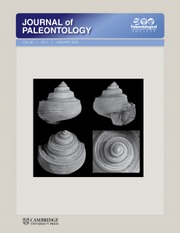Crossref Citations
This article has been cited by the following publications. This list is generated based on data provided by
Crossref.
Rahman, Imran A.
and
Smith, Selena Y.
2014.
Virtual paleontology: computer-aided analysis of fossil form and function.
Journal of Paleontology,
Vol. 88,
Issue. 4,
p.
633.
Wood, Jamie R.
and
De Pietri, Vanesa L.
2015.
Next-generation paleornithology: Technological and methodological advances allow new insights into the evolutionary and ecological histories of living birds.
The Auk,
Vol. 132,
Issue. 2,
p.
486.
Jablonski, David
and
Shubin, Neil H.
2015.
The future of the fossil record: Paleontology in the 21st century.
Proceedings of the National Academy of Sciences,
Vol. 112,
Issue. 16,
p.
4852.
Sharp, Alana C.
2015.
Comparative finite element analysis of the cranial performance of four herbivorous marsupials.
Journal of Morphology,
Vol. 276,
Issue. 10,
p.
1230.
Fortuny, Josep
Marcé-Nogué, Jordi
Heiss, Egon
Sanchez, Montserrat
Gil, Lluis
Galobart, Àngel
and
Jeffery, Nathan
2015.
3D Bite Modeling and Feeding Mechanics of the Largest Living Amphibian, the Chinese Giant Salamander Andrias davidianus (Amphibia:Urodela).
PLOS ONE,
Vol. 10,
Issue. 4,
p.
e0121885.
Polly, P. David
Stayton, C. Tristan
Dumont, Elizabeth R.
Pierce, Stephanie E.
Rayfield, Emily J.
and
Angielczyk, Kenneth D.
2016.
Combining geometric morphometrics and finite element analysis with evolutionary modeling: towards a synthesis.
Journal of Vertebrate Paleontology,
Vol. 36,
Issue. 4,
p.
e1111225.
Lautenschlager, Stephan
2016.
Reconstructing the past: methods and techniques for the digital restoration of fossils.
Royal Society Open Science,
Vol. 3,
Issue. 10,
p.
160342.
Sharp, Alana C.
and
Rich, Thomas H.
2016.
Cranial biomechanics, bite force and function of the endocranial sinuses in Diprotodon optatum, the largest known marsupial.
Journal of Anatomy,
Vol. 228,
Issue. 6,
p.
984.
Button, David J.
Barrett, Paul M.
Rayfield, Emily J.
and
Benson, Roger
2016.
Comparative cranial myology and biomechanics of Plateosaurus and Camarasaurus and evolution of the sauropod feeding apparatus.
Palaeontology,
Vol. 59,
Issue. 6,
p.
887.
Berthaume, Michael A.
2016.
On the Relationship Between Tooth Shape and Masticatory Efficiency: A Finite Element Study.
The Anatomical Record,
Vol. 299,
Issue. 5,
p.
679.
Lautenschlager, Stephan
2016.
DIGITAL RECONSTRUCTION OF SOFT-TISSUE STRUCTURES IN FOSSILS.
The Paleontological Society Papers,
Vol. 22,
Issue. ,
p.
101.
Goyens, Jana
Dirckx, Joris
and
Aerts, Peter
2016.
Jaw morphology and fighting forces in stag beetles.
Journal of Experimental Biology,
Therrien, François
Quinney, Annie
Tanaka, Kohei
and
Zelenitsky, Darla K.
2016.
Accuracy of mandibular force profiles for bite force estimation and feeding behavior reconstruction in extant and extinct carnivorans.
Journal of Experimental Biology,
Matthews, Gregory J.
Thiruvathukal, George K.
Luetkemeier, Maxwell P.
Brophy, Juliet K.
and
Lozano, Sergi
2017.
Examining the use of Amazon’s Mechanical Turk for edge extraction of the occlusal surface of fossilized bovid teeth.
PLOS ONE,
Vol. 12,
Issue. 7,
p.
e0179757.
Di Vincenzo, Fabio
Profico, Antonio
Bernardini, Federico
Cerroni, Vittorio
Dreossi, Diego
Schlager, Stefan
Zaio, Paola
Benazzi, Stefano
Biddittu, Italo
Rubini, Mauro
Tuniz, Claudio
and
Manzi, Giorgio
2017.
Digital reconstruction of the Ceprano calvarium (Italy), and implications for its interpretation.
Scientific Reports,
Vol. 7,
Issue. 1,
Fortuny, Josep
Marcé‐Nogué, Jordi
and
Konietzko‐Meier, Dorota
2017.
Feeding biomechanics of Late Triassic metoposaurids (Amphibia: Temnospondyli): a 3D finite element analysis approach.
Journal of Anatomy,
Vol. 230,
Issue. 6,
p.
752.
Rahman, Imran A.
and
Smith, Andrew
2017.
Computational fluid dynamics as a tool for testing functional and ecological hypotheses in fossil taxa.
Palaeontology,
Vol. 60,
Issue. 4,
p.
451.
Lautenschlager, Stephan
and
Porro, Laura
2017.
Functional niche partitioning in Therizinosauria provides new insights into the evolution of theropod herbivory.
Palaeontology,
Vol. 60,
Issue. 3,
p.
375.
DeSantis, Larisa R. G.
Tseng, Zhijie Jack
Liu, Jinyi
Hurst, Aaron
Schubert, Blaine W.
and
Jiangzuo, Qigao
2017.
Assessing niche conservatism using a multiproxy approach: dietary ecology of extinct and extant spotted hyenas.
Paleobiology,
Vol. 43,
Issue. 2,
p.
286.
Marcé-Nogué, Jordi
De Esteban-Trivigno, Soledad
Püschel, Thomas A.
and
Fortuny, Josep
2017.
The intervals method: a new approach to analyse finite element outputs using multivariate statistics.
PeerJ,
Vol. 5,
Issue. ,
p.
e3793.

